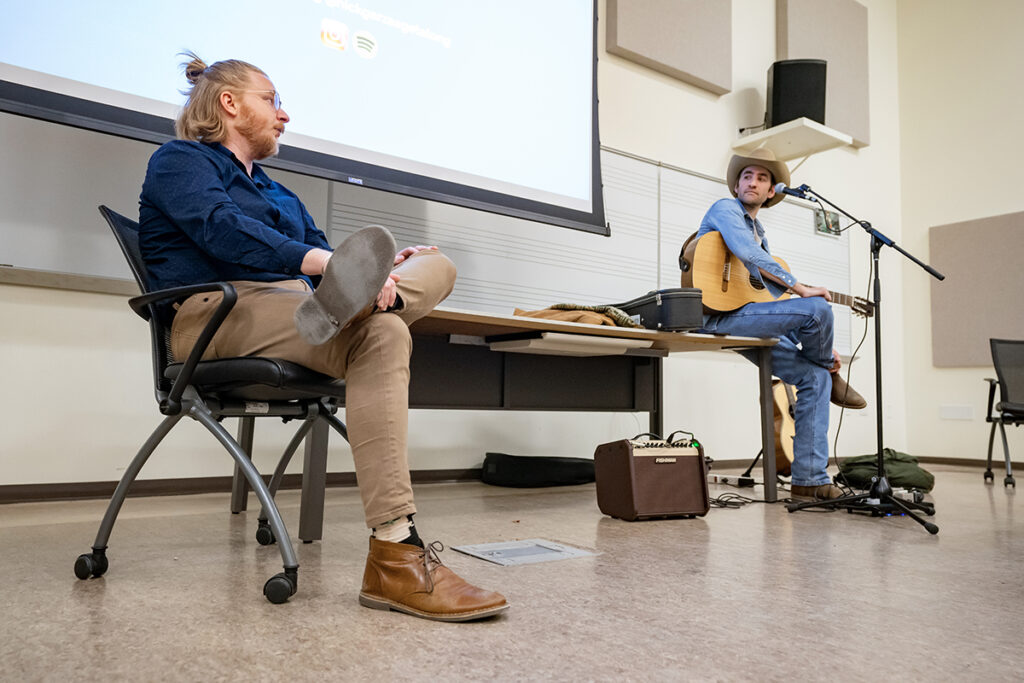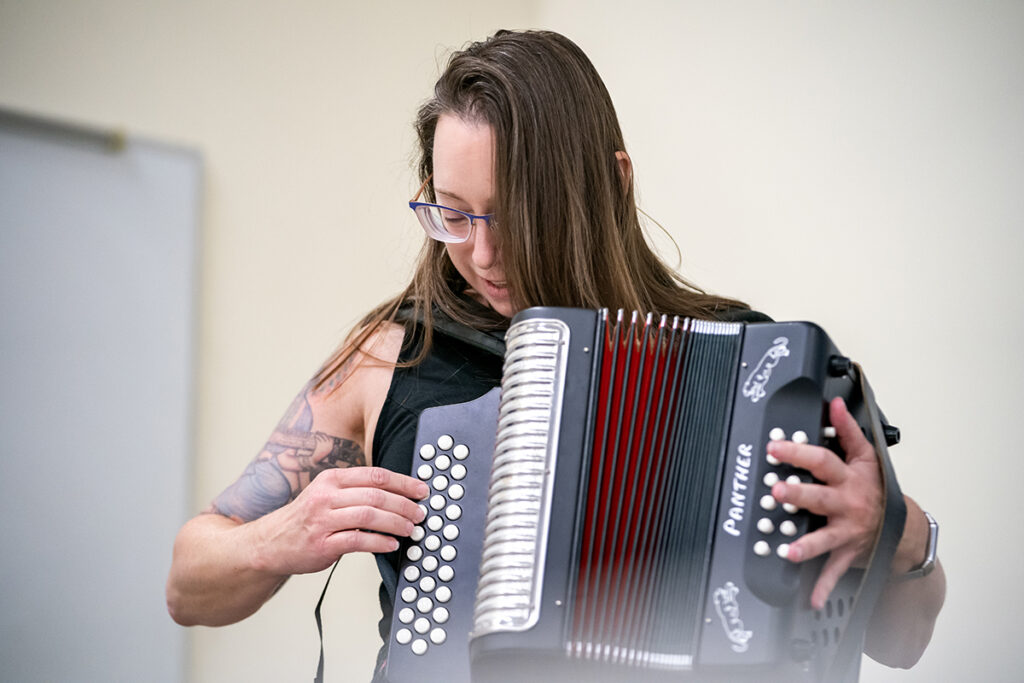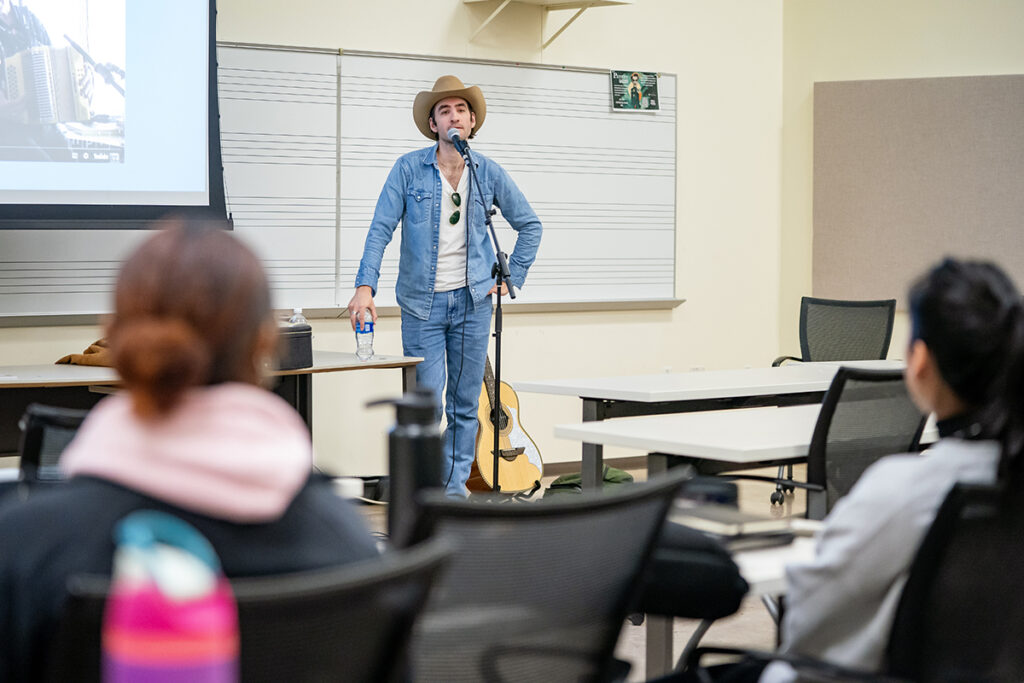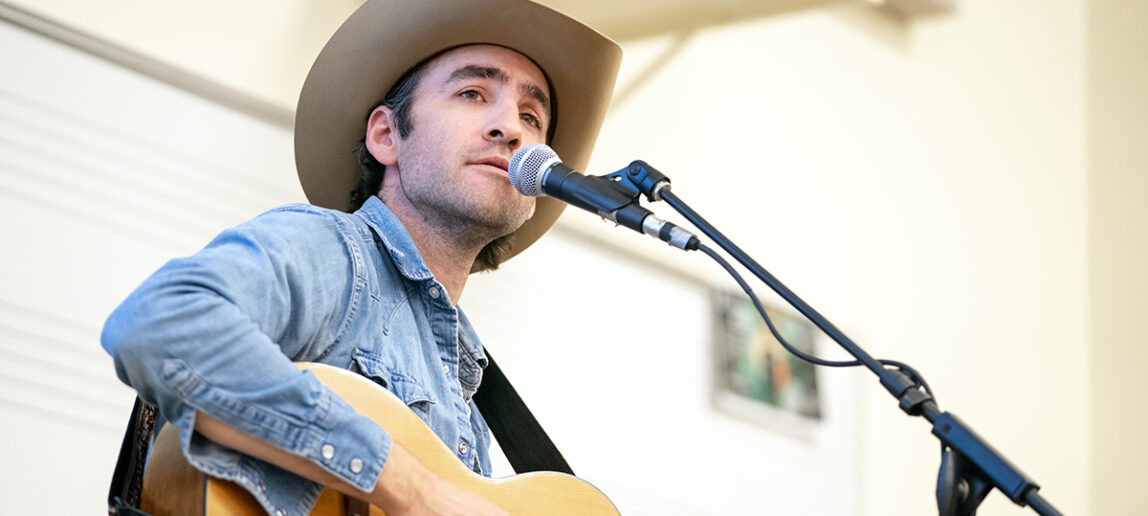Singer-Songwriter Nick Garza Explores Tejano Music History In Performance Studies Classes
Singer-songwriter Nick Garza visited students in Performance Studies classes on Nov. 2 to discuss his Texas roots and Tejano music background.
The San Antonio native was invited by Cory LaFevers, who teaches History of Country and Western Music and Seminar in Identity, Intersectionality and Performance, to explore the Tejano genre with students.
“We are in the middle of a unit that is exploring racial identities in country,” LaFevers said. “I wanted to bring someone doing Tejano music to illustrate that Latino people are writing country music and traditional genres that are related to country.”
Garza labels his music as “Tex-eclectic” country and performs with his band, Nick Garza’s Get Along. His influences include progressive and outlaw country, Tex-Mex conjunto and Western swing, LaFevers said.
Garza, who LaFevers noted is a 13th generation Texan, said his love of Tejano music flourished once he discovered his family’s connection to the genre.
“My family has been here since the 1600s,” Garza said. “I have Spanish and German ancestry, and I love Texas. I have a lot of roots here and that really inspires my own creativity and why I care about history in general. Music is a living history. Everything you hear is inspired by something before it.”

Garza grew up in San Antonio and graduated from the University of Texas with a degree in advertising. He performs in Austin at various venues and works as a freelance advertising creative.
During the class, LaFevers and Garza presented the history of Tejano music and how it originated with key instruments. Garza said Tejano is traditionally called conjunto, and is a result of German, Czech and Polish immigrants who moved to Texas and Mexico in the 1800s.
“They brought their accordions with them, which wasn’t an instrument that was popular at the time, neither in Spanish Colonial Texas, or Mexican Texas, or the Texas Republic,” Garza said. “But they brought their polka music and their waltzes, and the locals decided to embrace this music and make it their own. Around the 1930s in Texas and Mexico, they started creating music called conjunto, which is primarily button accordion and bajo sexto.”
Garza plays the bajo quinto, a 10-string version of the 12-string bajo sexto, which he described as a combination of guitar and bass guitar, noting that it serves as a replacement for the tuba played in polka music.
The accordion is a staple sound in Tejano music, LaFevers said, and is challenging to learn. Dr. Kim Kattari, program director for Performance Studies, played a brief demonstration on an accordion and noted the complexities of the instrument.

As Garza expanded on the history, he highlighted Tex-Mex music legends like the Texas Tornados supergroup that featured Flaco Jiménez, Augie Meyers, Max Baca, Freddy Fender and Doug Sahm. He showed an old clip of the band playing “(Hey Baby) Que Paso” on “Austin City Limits” and said performances like that changed how people viewed Tejano music.
Jiménez, the influential accordionist from San Antonio, visited Garza’s family’s ranch for a promotional photography shoot in the late 1990s.
“I was young at the time and didn’t understand the importance of who Flaco was,” Garza recalled. “But once I grew up and discovered his music, and after getting to meet him, he influenced my taste in music. I have since been able to record with some of his bandmates, including Max Baca and Augie Meyers at the beginning of 2020.”
The collaboration with Meyers began by Garza asking how he could get him to play on one of his songs. Meyers told him that if he liked the song, he would play on it. In early 2020, Garza shared with Meyers a song he wrote that he had no intention of recording, but he thought that Meyers might enjoy.
“When he heard the song, he loved it,” Garza said. “He brought together a group of Grammy Award-winning musicians, Max and Josh Baca of Los Texmaniacs, and we put out my song ‘Muchacha.’”
Meyers played the vox organ keyboard and some piano accordion on the song, with Max Baca on the bajo sexto and his nephew Josh Baca on button accordion. Working with both legends prompted Garza to make more Tex-Mex music, and he said he was grateful to become close friends with them.

Garza and LaFevers also discussed country genres and how to define them, how dancing and instruments have influenced modern country music, and the importance of dance halls and how they have influenced Tejano and Western music.
Students asked Garza questions about his work. One question focused on where his inspiration comes from.
“It just depends on my mood, but different genres influence me,” Garza said. “I listen to a lot of Willie Nelson. His lyrics are really amazing. He is able to say exactly what he needs to say in as few words as possible and they hit you hard. That is what I challenge myself to do in my writing. A lot of the time though, my writing process starts by picking up a guitar or banjo and just ad-libbing.”
Toward the end of the lecture, Garza performed two of his songs: “Out of Her Mind” and “Denial.” He also showed the music videos for his songs “I’ll Take Another Margarita” and “Another Bloody Morning.”
After the class, Garza said the beauty in Tejano music is it brings people together, no matter their background.
“It is first and foremost dance music,” he said. “There are some more sentimental songs, but it’s a lot of polka and waltzes, and the polkas especially are upbeat. Even if you don’t speak Spanish or German or whatever the language is, you can feel it.”
Garza said he hopes the students are able to appreciate Tejano music and understand how all music is intertwined.
“There is a rich history in this music,” he said. “I hope they would want to research more on their own, dig into these old bands, find some videos online, really embrace it and change their perspective on what this music is.”

